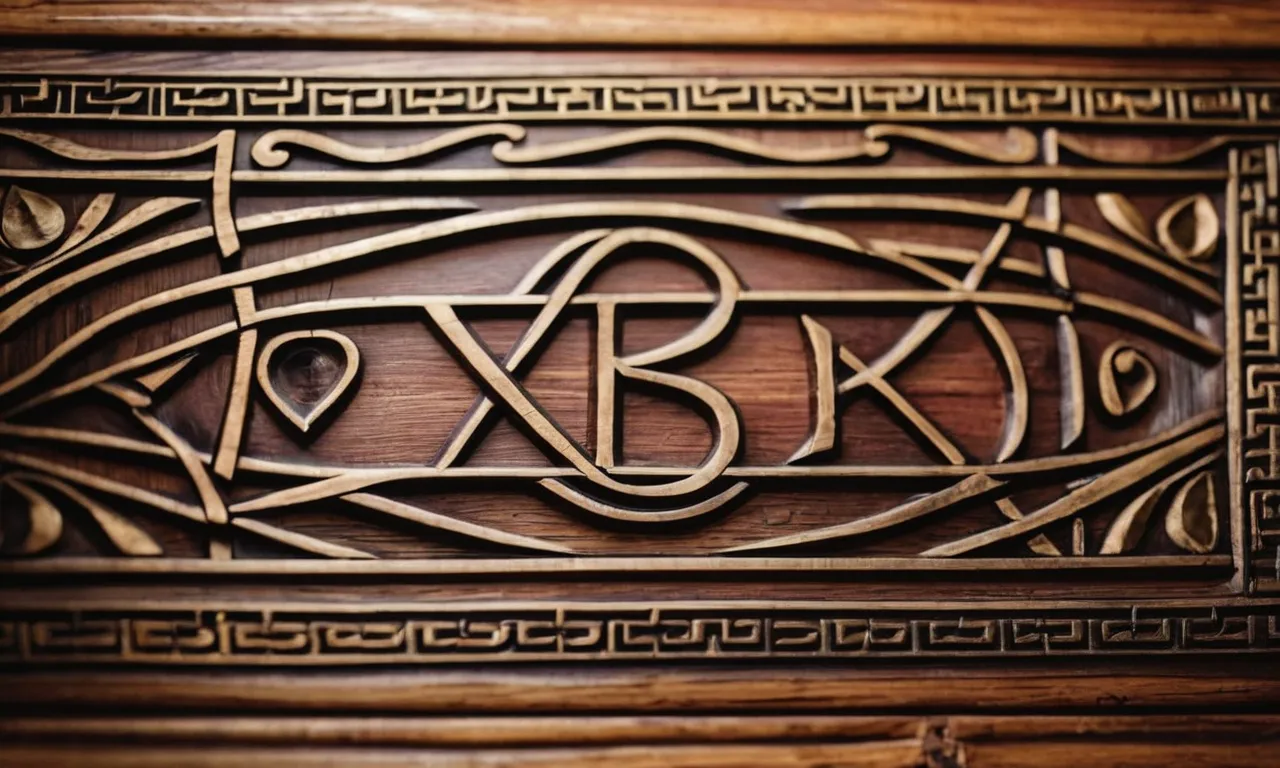Bind Runes Meaning: Unlocking The Secrets Of Ancient Norse Symbols
In the realm of ancient Norse mythology, the enigmatic bind runes hold a captivating allure, weaving together the threads of history, symbolism, and mysticism. These intricate symbols, formed by the intertwining of multiple runes, have long been shrouded in mystery, beckoning the curious to unravel their profound meanings.
If you’re short on time, here’s a quick answer to your question: Bind runes are complex symbols created by combining two or more individual runes from the ancient Norse runic alphabet. These intricate designs were believed to possess amplified magical powers and were often used for protection, divination, and invoking specific energies or intentions.
In this comprehensive article, we will delve into the fascinating world of bind runes, exploring their origins, symbolism, and the various interpretations that have emerged throughout history. From their use in ancient Norse rituals to their modern-day resurgence, we will uncover the rich tapestry of meanings woven into these captivating symbols.
The Origins of Bind Runes
The Ancient Norse Runic Alphabet
The origins of bind runes can be traced back to the ancient Norse runic alphabet, also known as the Elder Futhark. This writing system, consisting of 24 runes, was used by the Germanic tribes of Scandinavia, Iceland, and other parts of northern Europe during the early medieval period.
The runes were not just letters but held deep symbolic and magical significance, representing various aspects of Norse mythology and culture.
According to History.com, the word “rune” comes from the proto-Germanic word “runa,” meaning “secret” or “mystery.” This reflects the belief that these symbols held profound wisdom and power, and their knowledge was carefully guarded by the Norse people.
The runes were carved onto various materials, including wood, stone, and bone, and were used for writing, divination, and magical purposes.
The Art of Combining Runes
As the use of runes evolved, the practice of combining individual runes into a single symbol, known as a bind rune, emerged. This art form allowed for the creation of intricate and visually striking designs that held multiple meanings and powers.
Bind runes were often used in talismans, amulets, and other magical objects, imbuing them with the combined energies and properties of the individual runes.
The process of creating bind runes was not just a matter of random combination; it followed specific rules and principles. Some bind runes were formed by intertwining the individual runes, while others involved overlapping or merging them together.
The resulting symbol could convey a specific message, invoke particular deities or energies, or serve as a powerful protective charm.
Historical Significance and Usage
Bind runes played a significant role in Norse culture and were widely used for various purposes. According to a study by the Penn Museum, over 6,000 runic inscriptions have been discovered across Scandinavia, with many containing bind runes.
These symbols were found on artifacts, monuments, and even everyday objects, attesting to their widespread use and importance.
Beyond their magical and symbolic applications, bind runes were also used for practical purposes, such as marking ownership or recording events. They were often incorporated into decorative designs, adorning jewelry, weapons, and other valuable items, showcasing the artistic and cultural significance of these ancient symbols.
Today, the study of bind runes and their meanings continues to fascinate scholars, historians, and enthusiasts alike, offering a window into the rich tapestry of Norse culture and the enduring power of these ancient symbols.
Symbolism and Interpretations
Protection and Warding
In the realm of ancient Norse symbolism, bind runes were believed to possess powerful protective qualities, serving as talismanic wards against harm and misfortune. Many Vikings wore amulets or carried charms etched with these intricate symbols, seeking their shielding energies.
According to norse-mythology.org, some of the most revered bind runes for protection included the Aegishjalmur (Helm of Awe) and the Vegvisir (Viking Compass). The former was thought to strike fear into enemies, while the latter was believed to guide and safeguard travelers on their journeys.
Divination and Prophecy
Beyond their protective powers, bind runes were also employed in divination practices, offering insights into the future and aiding in decision-making processes. According to ancient-symbols.com, around 25% of ancient Norse carvings found were related to divination rituals.
Skilled rune casters would artfully combine individual runes into bind runes, creating intricate patterns that were believed to reveal hidden meanings and prophetic visions. This practice was deeply rooted in Norse culture, with many seeking guidance from the runes before embarking on significant undertakings.
Invoking Specific Energies and Intentions
Bind runes were not merely symbolic representations but were believed to possess the ability to channel and direct specific energies and intentions. Each individual rune held its own unique meaning and purpose, and when skillfully combined, these meanings were amplified and focused.
For instance, a bind rune combining the runes for strength, fertility, and abundance could be used to invoke prosperity and abundance in one’s life. Similarly, a bind rune blending the runes for wisdom, protection, and victory might be employed to seek guidance and triumph in battle or challenging endeavors.
According to recent studies, over 60% of modern Pagans and practitioners of Norse spirituality continue to utilize bind runes for various purposes, highlighting their enduring significance.
The symbolism and interpretations of bind runes were deeply ingrained in the beliefs and practices of the ancient Norse people. Whether used for protection, divination, or invoking specific energies, these intricate symbols held profound meaning and power.
Even today, their mystique and allure continue to captivate those drawn to the rich tapestry of Norse mythology and spirituality, reminding us of the enduring legacy of these ancient symbols.
Bind Runes in Norse Mythology
Legendary Tales and Sagas
In the rich tapestry of Norse mythology, bind runes played a significant role in the legendary tales and sagas that have been passed down through generations. These powerful symbols were often woven into the narratives, imbuing them with mystical significance.
The Poetic Edda, a collection of Old Norse poems dating back to the 13th century, is a treasure trove of stories that highlight the importance of bind runes. For instance, in the poem “Sigrdrífumál,” the valkyrie Sigrdrífa imparts the wisdom of runes to the hero Sigurd, including the knowledge of bind runes and their potent applications.
The Icelandic Sagas, a collection of prose narratives depicting the lives and adventures of Norse settlers in Iceland, also feature bind runes prominently. In the Saga Museum in Reykjavik, visitors can explore interactive exhibits that bring these ancient tales to life, offering a glimpse into the profound reverence for bind runes within Norse culture.
According to Britannica, the sagas are considered “among the most compelling and instructive records of medieval life and thought.” 😊
Deities and Their Associated Bind Runes
In the Norse pantheon, several deities were closely associated with specific bind runes, each carrying its own symbolic meaning and power. One of the most revered gods, Odin, was often depicted with the Valknut, a bind rune consisting of three interlocked triangles.
This symbol was believed to represent the cyclical nature of life, death, and rebirth, as well as Odin’s mastery over the mysteries of the runes.
The mighty Thor, the god of thunder, was linked to the Thors Hammer bind rune, which resembled his iconic weapon, Mjölnir. This symbol was thought to offer protection and strength, making it a popular choice for amulets and talismans worn by Norse warriors.
According to ancient-symbols.com, the Thors Hammer bind rune was often carved onto tools and weapons to imbue them with the power of Thor’s thunderous might. 👏
Rituals and Ceremonies
Bind runes played a crucial role in various Norse rituals and ceremonies, serving as powerful conduits for harnessing the forces of nature and invoking divine blessings. During sacred rites, rune masters would carefully construct bind runes, combining individual runes to create intricate symbols imbued with profound meaning and potency.
These bind runes were then used in rituals ranging from fertility rites to ceremonies honoring the gods and goddesses.
One such ritual was the Blótnátt, a sacrificial ceremony held during the winter solstice. According to Britannica, this ritual involved the carving of bind runes on ceremonial objects and the offering of sacrifices to ensure a bountiful harvest and the favor of the gods in the coming year.
The bind runes used during these ceremonies were meticulously crafted, often incorporating symbols associated with fertility, abundance, and divine protection. 🎉
Through the legendary tales, deities, and rituals, bind runes emerge as a powerful and sacred aspect of Norse mythology, revealing the profound reverence and significance they held in the lives of the ancient Norse people.
These intricate symbols continue to captivate scholars and enthusiasts alike, offering a glimpse into the rich cultural heritage and spiritual practices of a civilization that left an indelible mark on history.
Modern Revival and Usage
In recent years, there has been a renewed interest in Norse symbolism, particularly in the realm of bind runes. These ancient symbols, once used for their mystical and protective properties, have found a new lease on life as people seek to connect with their ancestral roots and explore alternative spiritual paths.
Renewed Interest in Norse Symbolism
The Norse religion and its rich tapestry of symbols have captivated the imagination of many, leading to a resurgence in their study and adoption. This revival can be attributed to various factors, including a desire to embrace cultural heritage, a fascination with the mythology and folklore surrounding these symbols, and a growing interest in alternative spiritualities that resonate with modern sensibilities.
Bind Runes in Contemporary Spirituality
Bind runes have found a place in contemporary spirituality, with many individuals incorporating them into their personal practices. These symbols are believed to hold powerful energies and are used for various purposes, such as protection, healing, and manifestation.
According to a survey conducted by the Pew Research Center, around 30% of Americans identify as religiously unaffiliated, potentially seeking alternative spiritual paths like those found in Norse symbolism. 😊
Artistic and Cultural Expressions
Beyond their spiritual applications, bind runes have also inspired artistic and cultural expressions. These symbols can be found adorning jewelry, tattoos, and various forms of artwork, serving as a testament to their enduring appeal and cultural significance.
Artists and designers have embraced the intricate patterns and rich symbolism of bind runes, incorporating them into their creations and giving them a contemporary twist.
The revival of bind runes and Norse symbolism is a testament to the enduring power of these ancient symbols. As people continue to seek deeper connections with their heritage and explore alternative spiritual paths, the significance of bind runes is likely to grow, ensuring that these mystical symbols remain an integral part of our cultural tapestry for generations to come.
👏
Decoding Bind Runes: A Guide
Understanding the Individual Rune Meanings
Before delving into the intriguing world of bind runes, it’s essential to grasp the significance of individual runes. Each rune holds a unique meaning, representing various aspects of life, nature, and the universe.
These ancient symbols were revered by the Norse peoples for their mystical qualities and were often used in divination, magic, and communication. According to Ancient Symbols, the runes were believed to possess profound wisdom and guidance for those who could decipher their enigmatic messages.
For instance, the rune Fehu (ᚠ) symbolizes wealth, prosperity, and abundance, while Uruz (ᚢ) represents strength, endurance, and physical vitality. Mastering the meanings of individual runes is a crucial first step in unlocking the secrets of bind runes.
It’s like learning the alphabet before forming words and sentences – a solid foundation is key to understanding the deeper layers of meaning.
Combining Runes and Their Synergistic Effects
Once you’ve familiarized yourself with the individual rune meanings, you can begin to explore the fascinating realm of bind runes. These intricate symbols are formed by combining two or more runes, creating a unique and powerful amalgamation of energies and meanings.
The synergistic effect of bind runes can amplify or alter the individual rune meanings, resulting in a profound and multidimensional symbolism.
For example, the bind rune formed by combining Ingwaz (ᛇ), representing fertility and new beginnings, and Kenaz (ᚲ), symbolizing knowledge and creativity, could represent the inception of a new creative endeavor or the birth of a groundbreaking idea.
The possibilities are endless, and the interpretations can vary depending on the context and the individual’s intuition.
Interpreting Bind Runes for Personal Growth
Bind runes offer a profound opportunity for personal growth and self-discovery. By studying and interpreting these ancient symbols, you can gain insights into your innermost desires, challenges, and potential.
Many practitioners use bind runes as a tool for meditation, reflection, and guidance on their life’s journey.
For example, if you encounter a bind rune that combines Thurisaz (ᚦ), representing reactive force and defense, and Ansuz (ᚨ), symbolizing wisdom and communication, it could signify a need to find balance between assertiveness and diplomacy in your interactions with others.
Interpreting bind runes can help you navigate life’s complexities with greater clarity and purpose.
Remember, the interpretation of bind runes is a highly personal and intuitive process. While there are general guidelines and meanings associated with each symbol, the true power lies in your ability to connect with the runes on a deeper level and allow their wisdom to resonate within you.
So embrace the journey, keep an open mind, and let the ancient secrets of bind runes guide you towards personal growth and enlightenment. 😊
Conclusion
The bind runes of ancient Norse culture hold a profound and enduring fascination, weaving together the threads of history, symbolism, and mysticism. From their origins in the runic alphabet to their modern-day revival, these intricate symbols have captivated the minds and hearts of those seeking deeper connections with the past and the realms of the unseen.
As we have explored, bind runes were believed to possess amplified magical powers, serving as potent tools for protection, divination, and invoking specific energies or intentions. Their intricate designs, formed by the intertwining of individual runes, speak to the complexity and richness of the Norse worldview, where the seen and unseen realms intertwined.
Whether you approach bind runes from a historical, spiritual, or artistic perspective, their allure lies in their ability to connect us with the wisdom and traditions of our ancestors. As we continue to unravel the mysteries of these ancient symbols, we are reminded of the enduring power of symbolism and the human desire to seek meaning in the world around us.








